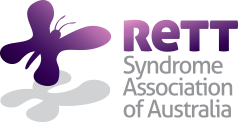Rett syndrome (RTT) which is seen almost exclusively in females, is a genetic disorder in which the brain does not mature in the way it should. For most children, their early development appears normal but then slows down or suddenly halts. This time of their lives can be marked by most, if not all of, the following:
- non-purposeful repetitive hand movement
- reduced eye contact
- night laughter
- screaming
- problems with walking
- loss of communication ability
- seizures
- breathing problems (breath holding, fast breathing, and/or air swallowing)
- electroencephalogram (EEG) irregularities
- slowing of head growth
- varying degree of intellectual disability.
As the child grows, most, if not all of, the following, may become apparent:
- muscle stiffness
- cold bluish-red feet and legs and/or small feet
- chewing/swallowing difficulties
- abnormal sleep patterns
- teeth grinding
- constipation
- spinal curvature
- growth retardation
- decreased body fat and muscle mass
- tip-toe walking
- decreased mobility.
Apraxia (dyspraxia) i.e., where the brain has difficulty putting in place the automatic planning needed to carry out voluntary movement, is the most fundamental and severely handicapping aspect of RTT.
The degree of disability varies considerably among affected individuals, so much so that two individuals of the same age can present two totally different pictures of the disorder. The syndrome is not one involving continual degeneration of the brain. However, over time, gross motor ability is likely to deteriorate. Generally, the condition is not one in which there is a continuous downward trend but one where times of improvement alternate with periods of impairment and deterioration.
The disorder was first brought to the attention of the medical profession in 1966 by an Austrian doctor, Andreas Rett, but it wasn’t until 1983, following publication of an article by Swedish researcher Bengt Hagberg and others, that females in Australia and elsewhere began to be diagnosed.
